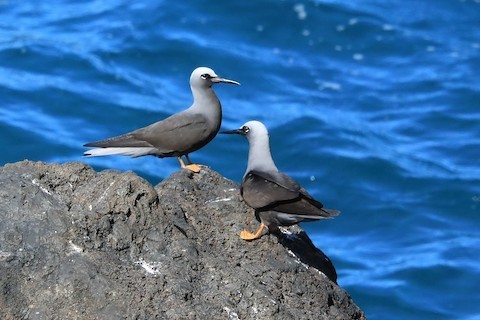Birdfinding.info ⇒ The Hawaiian endemic form of Black Noddy (or perhaps more likely a separate Hawaiian species) is locally common on each of the main islands. On Kauai, it is easy to find at Ha’ena State Park and along the Na Pali Coast, but not consistently elsewhere, though it is fairly regular in the vicinity of Kawaiele State Waterbird Sanctuary and Hanapepe. On Oahu, Kawainui Regional Park is probably the most reliable site, and it can often be found at Makapu’u Point, Ka’ena Point, and James Campbell National Wildlife Refuge. On Maui, there are colonies at Wai’anapanapa State Park, Ke’anae, and the Oheo Gulch area of Haleakala National Park. On the Big Island, consistent sites include Pololu, South Point, and the Coastal Chain of Craters Road in Hawaii Volcanoes National Park.
“Hawaiian Noddy”
Anous minutus melanogenys
Endemic to Hawaii. Resident along the coasts of the main Hawaiian Islands from Ni’ihau to the Big Island.

“Hawaiian Noddy,” A. m. melanogenys, on a typical lava-cliff-ledge perch. (Holei Sea Arch, Hawaii Volcanoes National Park, Big Island, Hawaii; September 4, 2019.) © Dean LaTray
Breeds year-round in small colonies on rocky cliffs and generally remains near breeding areas, feeding mainly in coastal waters.
The global population has been estimated at approximately 2,000 pairs. Significant colonies are: (1) near Ni’ihau, on Lehua Islet and Ka’ula Rock; (2) along Kauai’s Na Pali Coast; (3) on islets along the eastern coast of Oahu; (4) along the northwestern and northeastern coasts of Molokai; (5) along coasts of Kaho’olawe; (6) along the eastern coast of Maui; and (7) at several sites along the eastern coast of the Big Island.
It is also conceivable that some “Hawaiian Noddies” breed on islets of the Northwestern Chain, as-yet unrecognized or mistaken for “Pacific Black Noddies,” but this remains speculative.
Identification
Similar to other members of the Black Noddy complex, but somewhat shorter-billed, with more extensively pale-gray head and tail, browner wings, and typically orange feet.
Adults usually appear mostly gray on the head, neck, rump, tail, with darker, blackish-brown wings and back. The wings appear more blackish when freshly molted and become browner with wear.
The gray rump and tail often appear quite pale and differentiate “Hawaiian” from other Black Noddy forms.
The gray on the head is typically paler on the crown and nape, and gradually transitions to darker shades around the mantle and the sides of the neck.
The feet are typically some shade of orange, sometimes dull but more often bright.
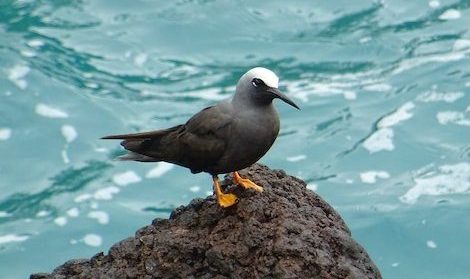
“Hawaiian Noddy,” A. m. melanogenys, showing vivid orange feet. (Wai’anapanapa State Park, Maui, Hawaii; August 12, 2018.) © Pablo Pascual
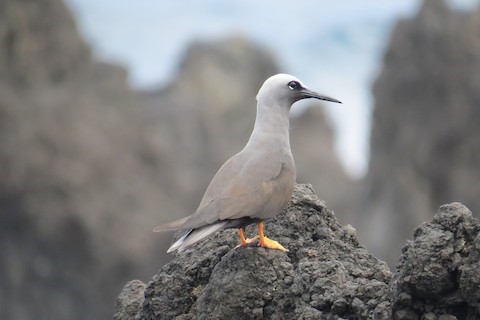
“Hawaiian Noddy,” A. m. melanogenys, appearing pale due to the lighting, and showing typically orange feet. (Wai’anapanapa State Park, Maui, Hawaii; March 10, 2016.) © Myron Gerhard
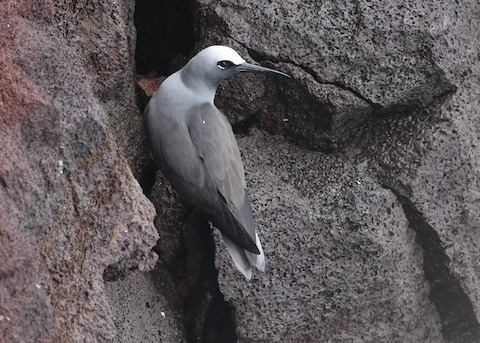
“Hawaiian Noddy,” A. m. melanogenys, appearing mostly pale-gray in this lighting. (Holei Sea Arch, Hawaii Volcanoes National Park, Big Island, Hawaii; September 4, 2019.) © Dean LaTray

“Hawaiian Noddy,” A. m. melanogenys. (Wai’anapanapa State Park, Maui, Hawaii; November 2, 2019.) © John Sullivan
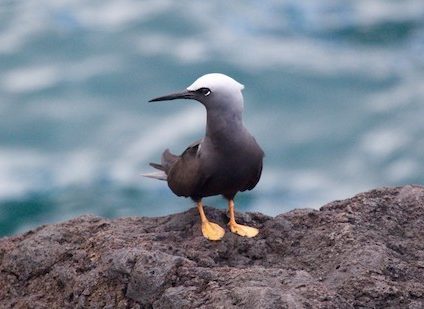
“Hawaiian Noddy,” A. m. melanogenys, showing vivid orange feet. (Wai’anapanapa State Park, Maui, Hawaii; January 22, 2016.) © Michael Hooper

“Hawaiian Noddy,” A. m. melanogenys, with dark feet—apparently a subadult. (Holei Sea Arch, Hawaii Volcanoes National Park, Big Island, Hawaii; September 4, 2019.) © Dean LaTray
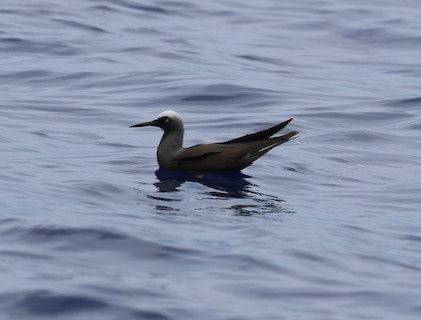
“Hawaiian Noddy,” A. m. melanogenys, appearing similar to “Pacific Black Noddy”—but note pale feet partly visible underwater. (Offshore from Kailua-Kona, Big Island, Hawaii; April 14, 2018.) © Joshua Rudolph
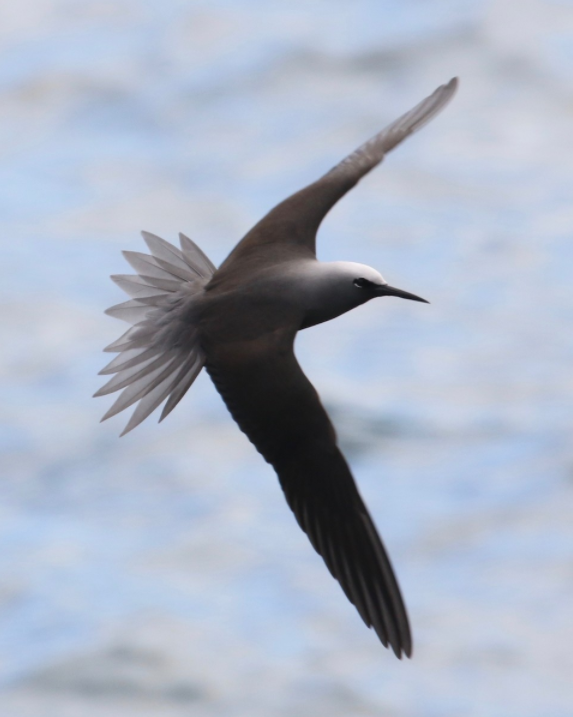
“Hawaiian Noddy,” A. m. melanogenys. (Whittington Beach Park, Big Island, Hawaii; March 16, 2017.) © Laurens Halsey

“Hawaiian Noddy,” A. m. melanogenys. (Whittington Beach Park, Big Island, Hawaii; March 16, 2017.) © Laurens Halsey
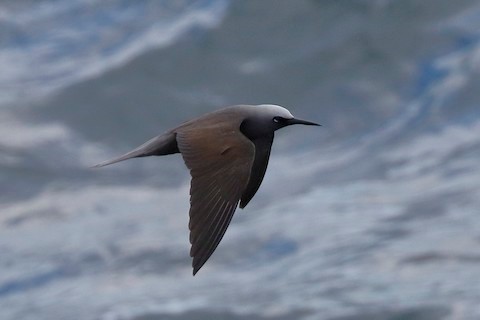
“Hawaiian Noddy,” A. m. melanogenys. (Coastal Chain of Craters Road, Hawaii Volcanoes National Park, Big Island, Hawaii; March 27, 2018.) © Sharif Uddin

“Hawaiian Noddy,” A. m. melanogenys, appearing exceptionally pale on the tail and head. (Wai’anapanapa State Park, Maui, Hawaii; January 22, 2016.) © Michael Hooper
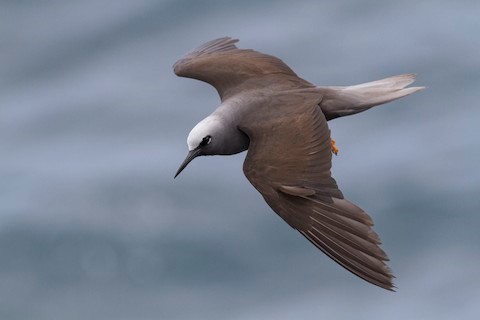
“Hawaiian Noddy,” A. m. melanogenys—note the partly visible orange foot. (Coastal Chain of Craters Road, Hawaii Volcanoes National Park, Big Island, Hawaii; July 4, 2016.) © Jacob Drucker

“Hawaiian Noddy,” A. m. melanogenys, showing strong contrast between blackish wings and pale-gray crown and tail. (Coastal Chain of Craters Road, Hawaii Volcanoes National Park, Big Island, Hawaii; April 6, 2016.) © Michael Pang
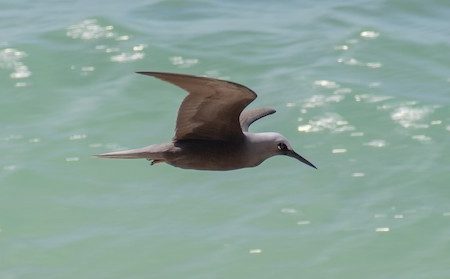
“Hawaiian Noddy,” A. m. melanogenys, appearing mostly pale in this lighting, and showing mostly grayish underparts. (Napili-Honokowai, Maui, Hawaii; March 6, 2020.) © Maxwell Ramey
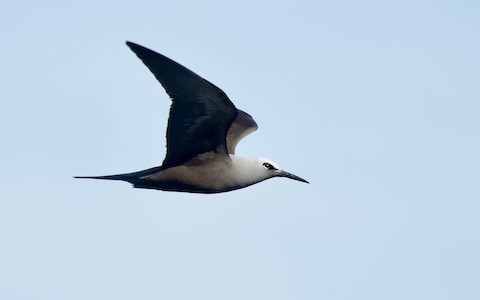
“Hawaiian Noddy,” A. m. melanogenys, appearing exceptionally pale in this lighting. (Lihua Islet, Hawaii; April 17, 2019.) © Lizabeth Southworth
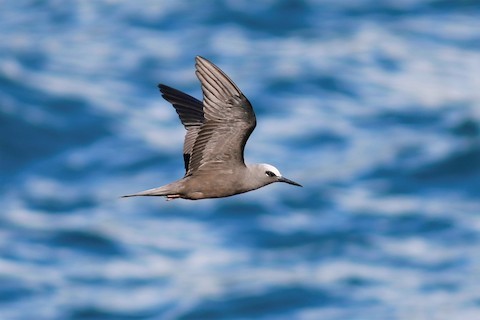
“Hawaiian Noddy,” A. m. melanogenys, showing mostly grayish underparts, appearing especially pale due to the lighting. (Wai’anapanapa State Park, Maui, Hawaii; November 2, 2020.) © John Sullivan
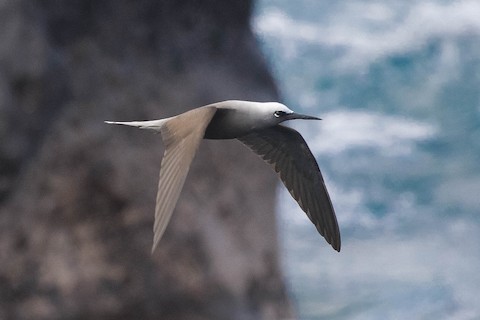
“Hawaiian Noddy,” A. m. melanogenys, appearing generally pale in this lighting, and showing mostly brown wings. (Wai’anapanapa State Park, Maui, Hawaii; January 22, 2016.) © Michael Hooper
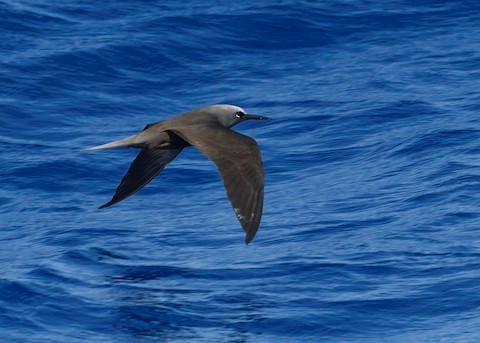
“Hawaiian Noddy,” A. m. melanogenys, appearing mostly dark in this view, but note especially the pale tail, which is diagnostic. (Kaulakahi Channel, Hawaii; April 3, 2016.) © Jacob Drucker

“Hawaiian Noddy,” A. m. melanogenys, showing strong contrast between brownish wings and pale-gray crown and tail. (Holei Sea Arch, Hawaii Volcanoes National Park, Big Island, Hawaii; September 4, 2019.) © Dean LaTray
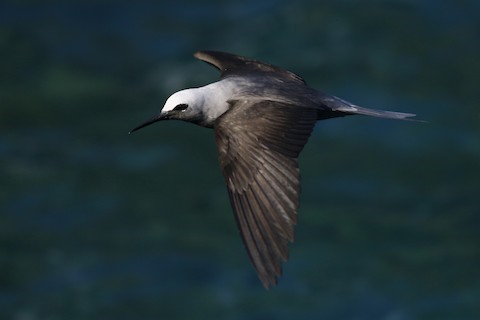
“Hawaiian Noddy,” A. m. melanogenys, with wings appearing blackish. (Wai’anapanapa State Park, Maui, Hawaii; November 2, 2019.) © John Sullivan
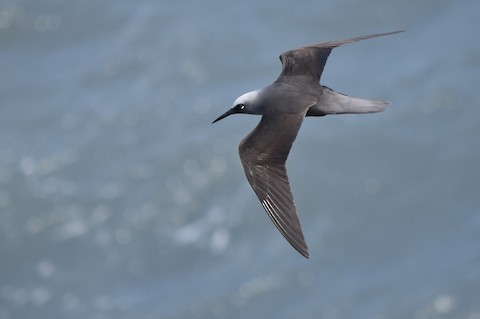
“Hawaiian Noddy,” A. m. melanogenys, with wings appearing blackish. (Coastal Chain of Craters Road, Hawaii Volcanoes National Park, Big Island, Hawaii; April 6, 2016.) © Michael Pang

“Hawaiian Noddy,” A. m. melanogenys, appearing mostly dark in this view, but note the pale tail, which is diagnostic. (Coastal Chain of Craters Road, Hawaii Volcanoes National Park, Big Island, Hawaii; August 16, 2019.) © Nathan O’Reilly
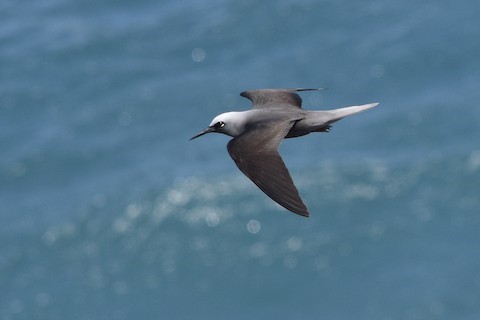
“Hawaiian Noddy,” A. m. melanogenys, showing strong contrast between blackish wings and pale-gray hood and tail. (Coastal Chain of Craters Road, Hawaii Volcanoes National Park, Big Island, Hawaii; April 6, 2016.) © Michael Pang
Immature Plumages. Immatures are darker than adults, blackish-brown overall with a partly whitish crown and dark feet. Unlike adults, their rumps and tails are typically concolor with the back. At some stages in their development, many immature “Hawaiians” may be effectively indistinguishable from “Pacific Black Noddy” (see below), which complicates analysis of the relationship between these forms.
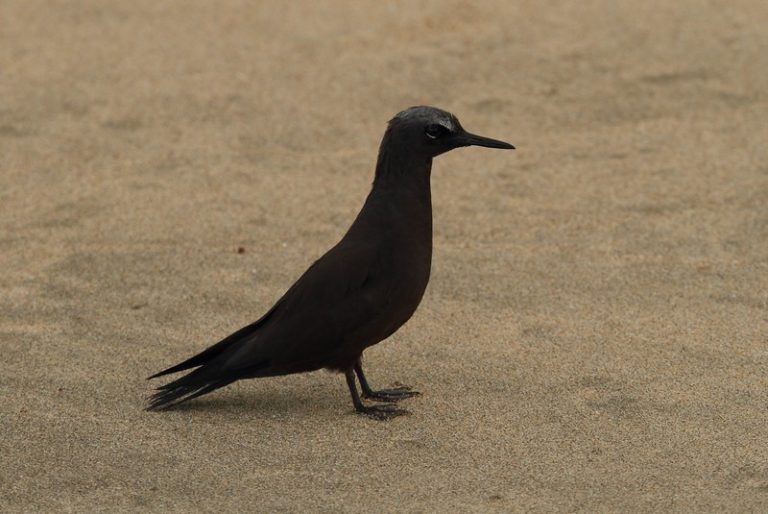
“Hawaiian Noddy,” A. m. melanogenys, juvenile—essentially all-dark, including the crown and the feet. (Kalalau Beach, Na Pali Coast State Park, Kauai, Hawaii; June 14, 2015.) © Patrick J. Blake
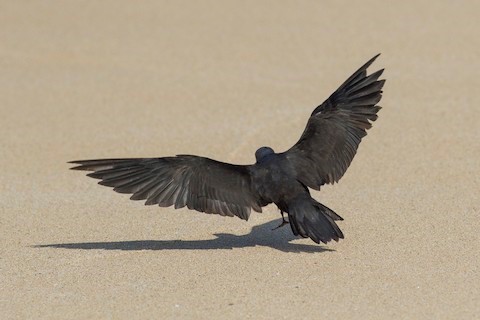
“Hawaiian Noddy,” A. m. melanogenys, immature, showing dark tail. (Kekaha Beach Park, Kauai, Hawaii; April 5, 2016.) © Jacob Drucker

“Hawaiian Noddy,” A. m. melanogenys, immature. (Kekaha Beach Park, Kauai, Hawaii; April 5, 2016.) © Jacob Drucker

“Hawaiian Noddy,” A. m. melanogenys, immature. (Kekaha Beach Park, Kauai, Hawaii; April 5, 2016.) © Jacob Drucker

“Hawaiian Noddy,” A. m. melanogenys, immature. (Kekaha Beach Park, Kauai, Hawaii; April 5, 2016.) © Jacob Drucker
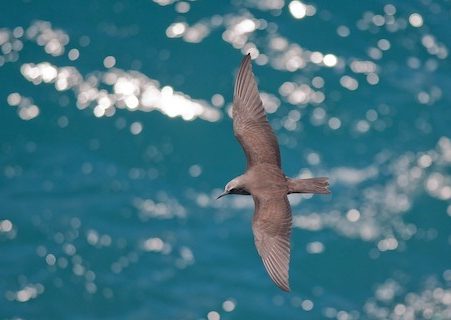
“Hawaiian Noddy,” A. m. melanogenys, immature. (Coastal Chain of Craters Road, Hawaii Volcanoes National Park, Big Island, Hawaii; July 25, 2015.) © Etienne Artigau
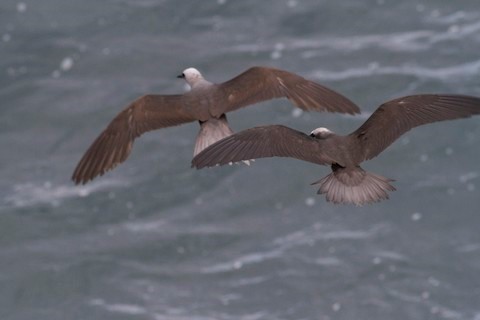
“Hawaiian Noddy,” A. m. melanogenys, apparently an adult and a subadult—based on its somewhat darker tail. (Coastal Chain of Craters Road, Hawaii Volcanoes National Park, Big Island, Hawaii; July 4, 2016.) © Jacob Drucker
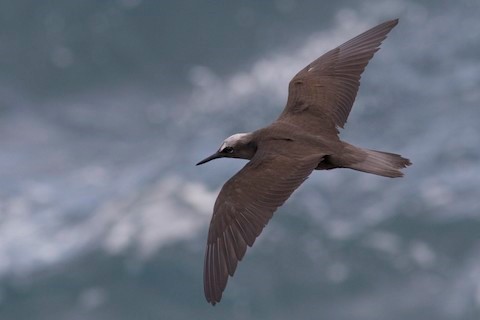
“Hawaiian Noddy,” A. m. melanogenys, immature showing some white on the crown and a subtly pale tone on the tail. (Coastal Chain of Craters Road, Hawaii Volcanoes National Park, Big Island, Hawaii; July 4, 2016.) © Jacob Drucker
Cf. “Pacific Black Noddy”. The “Hawaiian Noddy” is generally considered a subspecies of Black Noddy, but it seems likely to be recognized as a separate species eventually. Adult “Hawaiian” has distinctive features that differentiate it from the “Pacific Black Noddies” that sometimes occur with it—certainly around Ni’ihau, and possibly elsewhere in the main Hawaiian Islands. However, immature “Hawaiian” typically lacks the distinctive features of adults and in some cases may not be reliably differentiated from “Pacific Black”, so even well-documented photographic records of the latter in the main Hawaiian Islands are difficult to evaluate.
Tail Color: Most distinctively, “Hawaiian” has a gray (often pale gray) rump and tail that contrast with the darker back and belly. In almost all cases, “Pacific Black” has a blackish rump and tail that are concolor with the back and belly. In some instances, “Pacific Black” may show a slightly paler rump and tail, but this is atypical and would rarely approach the contrast in “Hawaiian’s” coloration.
Head Color: “Hawaiian” usually has a gray hood that is palest on the crown and gradually blends to darker shades, whereas “Pacific Black” has a white crown that contrasts boldly with its otherwise much darker plumage. This distinction is somewhat less reliable than the tail, however, because young “Hawaiians” have a more contrasty crown—roughly the same as typical “Pacific Blacks.” In addition, some “Pacific Blacks” seem to show less contrast than most and could be mistaken for “Hawaiians.”
Foot Color: “Hawaiian” typically has orange feet; “Pacific Black” typically has black feet; but there are many exceptions. Young “Hawaiians” have black or dark-brown feet and some adults may have very dull-looking feet. More confusingly, however, some “Pacific Blacks” (at least in some South Pacific populations far away from Hawaii) have variably paler, often orange feet.

An apparent “Pacific Black Noddy,” A. m. marcusi (or possibly a subadult “Hawaiian”) in a “Hawaiian Noddy” breeding colony—note the dark feet and strongly contrasting white crown compared to the orange feet and pale-gray hood of the adult “Hawaiian” below it. (Wai’anapanapa State Park, Maui, Hawaii; May 24, 2017.) © Nancy Christensen
Immatures: Immature “Hawaiian” is essentially all-dark and is easily mistaken for “Pacific Black.” Converse to the adult comparison, juvenile “Hawaiian” is more uniformly blackish than juvenile “Pacific Black” because “Hawaiian” typically begins with a dark crown whereas “Pacific Black” typically begins with a white crown. As they mature, “Hawaiians” become paler on the crown, elsewhere on the head and neck, and on the rump and tail—at one or more stages of this progression, they may be difficult or impossible to differentiate from “Pacific Black.”
Cf. Lesser Noddy. The ranges of “Hawaiian” and Lesser Noddies are far enough removed from one another that there is little potential for overlap. However, either of them could stray and if encountered in neutral territory out of their usual contexts they could easily be mistaken for one another.
Lesser has a proportionately longer bill than “Hawaiian”, and its feet are usually blackish whereas “Hawaiian’s” are usually some shade of orange. The two have similar head coloration but slightly different patterns, as Lesser typically has pale lores—which are noticeable at a distance as Lesser’s eye appears as an isolated dark patch on a mostly pale face.
“Hawaiian’s” rump and tail typically appear pale-gray (often whitish), whereas Lesser’s rump and tail typically appear black or blackish-brown. However, this feature, while distinctive on most “Hawaiians”, is somewhat inconsistent so some individuals may be intermediate.
Notes
Monotypic form, one of three distinct forms of Black Noddy (A. minutus), along with “Pacific Black” (minutus), and “Atlantic Black” (americanus), all potentially classifiable as separate species.
A fourth form, the Lesser Noddy (A. tenuirostris), was traditionally regarded as conspecific (with all four forms together known collectively as either Black, White-capped, or Lesser Noddy, A. tenuirostris) but is generally acknowledged to be a separate species—as it is visually distinctive and apparently breeds alongside “Pacific Black Noddy” at Ashmore Reef without interbreeding.
Howell and Zufelt (2019) recognize each of the four forms as separate species. In addition to Lesser, it seems appropriate to classify “Hawaiian” as separate based on factors that include pronounced differences in plumage, leg color, and bill length, and their persistence as recognizably distinct despite overlapping ranges.
Assuming that both Lesser and “Hawaiian” are ultimately recognized as separate species, biogeographic logic would tend to imply that the other two forms, “Atlantic Black” and “Pacific Black”, should be presumptively separate as well—although they are very similar and might not be reliably distinguishable.
References
eBird. 2020. eBird: An online database of bird distribution and abundance. Cornell Lab of Ornithology, Ithaca, N.Y. http://www.ebird.org. (Accessed June 17, 2020.)
Harrison, P. 1983. Seabirds: An Identification Guide. Houghton Mifflin, Boston.
Howell, S.N.G., and K. Zufelt. 2019. Oceanic Birds of the World. Princeton University Press.
Pratt, H.D., P.L. Bruner, and D.G. Berrett. 1987. A Field Guide to the Birds of Hawaii and the Tropical Pacific. Princeton University Press.
Pratt, H.D. 1993. Enjoying Birds in Hawaii: A Birdfinding Guide to the Fiftieth State (Second Edition). Mutual Publishing, Honolulu, Hawaii.
Pyle, R.L., and P. Pyle. 2017. The Birds of the Hawaiian Islands: Occurrence, History, Distribution, and Status. Version 2 (January 1, 2017). http://hbs.bishopmuseum.org/birds/rlp-monograph/. B.P. Bishop Museum, Honolulu, Hawaii.

